November 5,
2015
My first SE
Brazil tour has filled this year. It’s been two years since I birded in the
states of São Paulo and Rio de Janeiro, so I took advantage of the gap between
this upcoming tour and my SE Peru tour to do a quick refresher on the birds and
locations. Lucky for me, my good friends Keith Kamper and Patty Tersey of
Tucson were looking for an excuse to take their third birding trip to the
tropics, and I had no trouble convincing them to join me.
So for the
past nine days we covered most of my upcoming tour’s itinerary in reverse,
starting with our arrival in São Paulo and driving to Intervales State Park to
the south. We stayed the first night at a hotel after an ugly drive on
freeways, and then the next morning made our way to Intervales State Park. Even
before we got there a Slaty-breasted Wood-Rail walked across the road in front
of our car.
We met our
guide Renato (in the photo above) at the entrance to the park and we worked our
way to our lodging. A Double-collared Seedeater was singing along the way.
Near where
we parked Renato got us on a pair of Chestnut-backed Tanagers, a scarce bird
and the only ones we would see.
This is our
lodging; we had the entire house to ourselves.
Renato took us
to several areas over the next couple of days in search of Atlantic Rainforest
specialties. We were very successful. These are just the photo highlights.
White-eyed
Foliage-gleaner
Rufous-capped
Motmot
Swallow-tailed
Manakin
A
distinctive melastome, obvious from the leaf venation, but the small flowers
weren’t very showy. The relatively large anthers do have the distinctive
jointed structure.
Giant
Antshrike
Danaus erippus, Southern Monarch
Violet-crowned
Plovercrest
Epicadus heterogaster, a crab spider
These caterpillars
very closely resemble the communally roosting Morpho telemachus that have seen (and reared) at Cristalino Jungle
Lodge; these appear to be Morpho
epistrophus.
We saw two
or three of these Black-and-white Tegu each day.
This is a view
at Intervales just down the drive from our lodge.
This Swallow-tailed
Cotinga was nesting in the first tree to the right of the shed.
We had a
really productive night walk just down from our lodging. I recorded the songs
of more frogs that I saw, but I did finally find this Phyllomedusa distincta.
This Tawny-browed
Owl was along the same walk.
We saw two
kinds of harvestmen, probably in two very different families. I don’t know this
very slender one, missing two legs.
This is in
one of the Gonyleptoid families, probably Gonyleptidae.
Our next two
days were practically lost to travel and then 42 solid hours of rain. We were
holed up in our hotel in Cananéia in southern coastal São Paulo, and since we couldn’t get out to bird,
we missed the few species of specialties found here. I’ll return here with my
group and hope we have decent weather.
So this White-necked
Hawk photo jumps ahead a couple days and well up the São Paulo coast at the
private ranch Fazenda Angelim, near the small city of Ubatuba.
This was our
first day with no rain in three days, and it was gorgeous. This is a view from
Fazenda Angelim looking back towards Ubatuba. We eventually saw the very local
Buff-throated Purpletuft here.
Violet-capped
Woodnymph
Gray-hooded
Attila
I just
barely got a glimpse of this unknown snake as it slithered off a log crossing
the trail. I didn’t see the head, but the scales and pattern tell me it’s
probably a lancehead in the genus Bothrops,
probably B. jararaca.
About 20
miles back south is a private yard with bird feeders open to the public. Jonas
D’Abronzo has been feeding hummingbirds here for well over a decade and the
spectacle is amazing. He makes a sugar-water syrup of 1:4 by mass. That comes out to about 1:3 by
volume. He also puts out fruit for other birds.
Black
Jacobin
Amethyst
Woodstar
Festive
Coquette
Green-headed
Tanager
Red-necked
Tanager
We spent our
last two days at the lodge, ecological reserve, and large-scale habitat
restoration project known as REGUA, an abbreviation for Reserva Ecológica de
Guapiaçu, just an hour or so inland from the city of Rio de Janeiro.
On our one
full day here we hiked to this waterfall. It was lovely to see, and we did see
some White-collared Swifts zooming around and a Sharp-tailed Streamcreeper on
the rocks, but I hate not being able to hear birds when near waterfalls.
We saw lots
of great things along the 2-mile trail. This is a Black-cheeked Gnateater.
A puffball (name perhaps forthcoming)...
A slime mold
Pin-tailed
Manakin
At the lodge
I had the fortune of meeting Alan Martin, the creator of the Brazil
Hawkmoths website. It’s an impressive work which I had used in the past to
ID my own sphingids. At the lodge’s moth light was this Adhemarius palmeri.
This is a
silk moth in the genus Titaea, but it
seems that the taxonomy of this group is not yet sorted out.
The lodge
has a fruit feeder for birds, but Buffy-tufted Marmosets come down to take
their fill occasionally.
In the afternoon
we walked around the marsh for which REGUA is so well known.
A view
of the Serra do Mar from REGUA.
A Common
Pauraque on a nest next to the trail had been staked out for us.
For some
reason my eye caught this Cloudless Sulphur chrysalis, which I would normally
have overlooked as a leaf.
I somehow
was keyed on looking at small things. This Cordyceps sp. fungus (or a related
genus) was on many Coccinellid beetles (related to lady bugs) on a dead tree
trunk. I had actually stopped to look at a few live beetles that were also
hanging out there.
This
caterpillar, probably a moth, was feeding on a mistletoe cactus (Rhipsalis sp.), the epiphytic cactus
that is also found in Africa and on some Indian Ocean islands (and is the only
cactus to occur naturally outside the Americas).
Finally, in
the evening we drove to a nearby wet, brushy cattle pasture to try for Giant
Snipe. We heard one calling, then saw it in flight, then heard two or three
others. Eventually our local guide found one on the ground, and we were able to
quietly walk up on it.


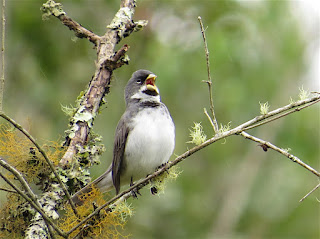








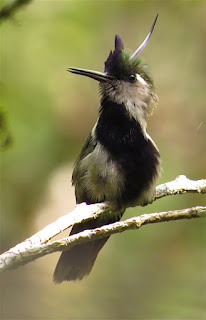





















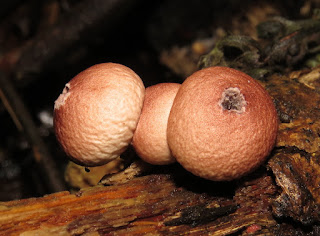




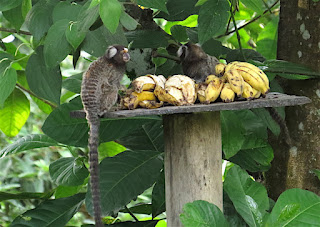


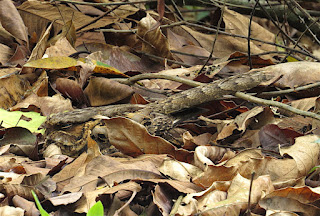

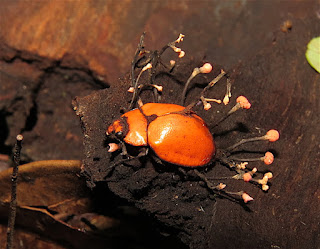

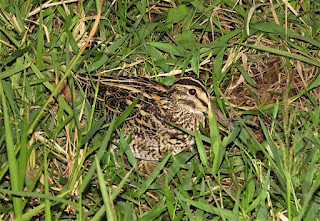





No comments:
Post a Comment